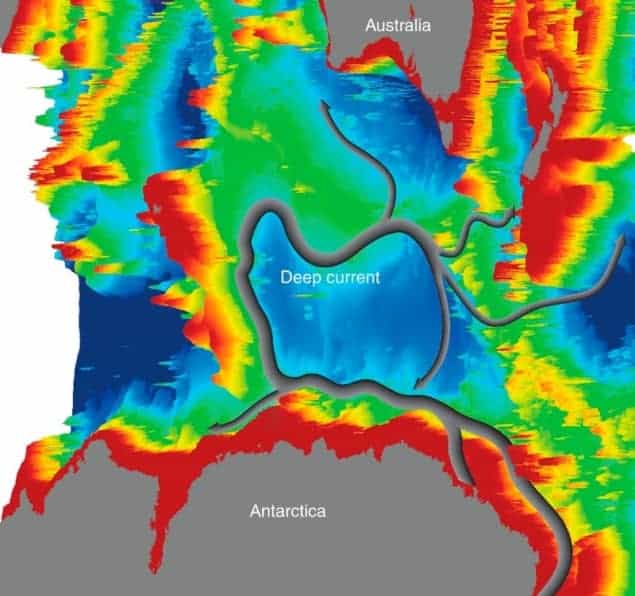
Researchers in Australia and Japan have offered our best view yet of a super-fast flow of water known to emerge from the depths below Antarctica. This flow, known as the Antarctic Bottom Water, feeds into the global ocean circulation, which is responsible for redistributing heat and salt throughout the world’s oceans.
Ocean scientists know that large quantities of near-freezing water, with temperatures of around –1.9 °C, sink at four main sites in the shelf seas around Antarctica. As these dense waters plummet to depth they gather momentum, entraining lighter waters, before veering north along the continental slope. The flow continues along the floor of the Southern Ocean, making its way along myriad channels until it finally reaches the adjoining ocean basins.
Very few specific details are known, however, about the flow of this Antarctic Bottom Water. Researchers know little for instance, about the quantities of water involved in this process and the speeds at which they travel. These are the kind of details that Yasushi Fukamachi at Hokkaido University, working with colleagues in Australia, have gleaned in this latest research. They deployed a number of mooring stations, equipped with sensitive equipment, to track the flow of the Antarctic Bottom Water in the shelf seas around Antarctica.
Narrow and intense flow
The researchers discovered a narrow and intense northward flow extending through the water column east of the Kerguelen Plateau – an underwater volcanic structure 3000 km to the southwest of Australia. Current meters also reveal the waters to be flowing at speeds exceeding 20 cm /s at depths below 3000 m, the highest speeds yet for this depth of water.
Our measurement was not the first to measure flow and velocity of Antarctic Bottom Water. However, we believe that ours is the best focused, fine-scale measurement ever. Yasushi Fukamachi, Hokkaido University
Fukamachi tells physicsworld.com that he was surprised by the “massive amount” of Antarctic Bottom Water carried by the deep currents. Indeed the researchers report a mean equator-ward flow of water colder than 0 °C exceeding 12 million cubic metres every second, which is compensated only partially by poleward flow. “Our measurement was not the first to measure flow and velocity of Antarctic Bottom Water. However, we believe that ours is the best focused, fine-scale measurement ever,” he says.
The findings shed light on the origins of the Antarctic Bottom Water, but more work needs to be done to track the full cycle of this flow. “We need to carry out the mooring measurement in the downstream regions of the Kerguelen plateau to evaluate the fate of the deep current to the east,” says Fukamachi.
Maintaining mild climates
Studying the Antarctic Bottom Water could give ocean scientists a clearer picture of deep water circulation throughout the southern hemisphere. This process, like North Atlantic circulation in the northern hemisphere, redistributes heat and salt to maintain the relatively mild global climate. It also supplies oxygen to the deep ocean.
Fukamachi warns that melting glaciers, as a result of rising sea and air temperatures, could disrupt this circulation. He explains that, “The resulting fresher surface water weakens the sinking of dense water around Antarctica and hence the outflow of the Antarctic Bottom Water. “Although we do not have observational data to show the weakened outflow of the Antarctic Bottom Water, the ship-based observations carried out during our mooring recovery cruise show the rapid decline of salinity of the Antarctic Bottom Water throughout the Australian Antarctic Basin.”
James McWilliams, an atmospheric and oceanic scientist at the University of California, Los Angeles, agrees that the Antarctic Bottom Water is vulnerable to changes in the global climate system. “Anthropogenic global change is warming and freshening the surface waters in subpolar regions, thus weakening the forcing for sinking into the abyss,” he says. He adds, “How much the sinking patterns will actually change, and how global climate will change as a result, are subtle issues for modelling to assess.”
This research is published in Nature Geoscience.




